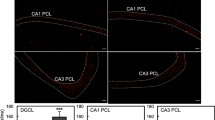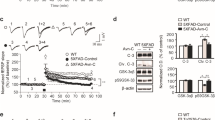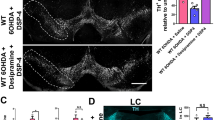Abstract
Adrenergic β receptor activation may ameliorate amyloid β toxicity. We examined whether isoproterenol, an adrenergic β receptor agonist reduces neurodegeneration caused by Aβ1-42, for which intracellular Zn2+ dysregulation is a trigger. Neurodegeneration was assessed in the dentate granule cell layer 14 days after intracerebroventricular injection of human Aβ1-42 into the mouse brain. Neurodegeneration was canceled after co-injection of isoproterenol. Isoproterenol did not affect Aβ staining (uptake) in the dentate granule cell layer 1 h after Aβ injection. In contrast, isoproterenol reduced intracellular Zn2+ level increased by Aβ. The synthesis of intracellular metallothioneins (MTs), Zn2+-binding proteins was not enhanced in the dentate granule cell layer 24 h after Aβ1-42 injection, but significantly enhanced after co-injection of isoproterenol. These data indicate that isoproterenol enhances MT synthesis and cancels neurodegeneration via intracellular Zn2+ toxicity after Aβ1-42 injection. It is likely that MT synthesis enhanced by adrenergic β receptor-mediated signaling contributes to ameliorating Aβ1-42 toxicity in the brain.





Similar content being viewed by others
References
Ardestani PM, Evans AK, Yi B, Nguyen T, Coutellier L, Shamloo M (2017) Modulation of neuroinflammation and pathology in the 5XFAD mouse model of Alzheimer’s disease using a biased and selective beta-1 adrenergic receptor partial agonist. Neuropharmacology 116:371–386
Beattie JH, Wood AM, Trayhurn P, Jasani B, Vincent A, McCormack G, West AK (2000) Metallothionein is expressed in adipocytes of brown fat and is induced by catecholamines and zinc. Am J Physiol Regul Integr Comp Physiol 278:R1082-1089
Bobillier-Chaumont S, Maupoil V, Berthelot A (2006) Metallothionein induction in the liver, kidney, heart and aorta of cadmium and isoproterenol treated rats. J Appl Toxicol 26:47–55
Brady FO, Helvig B (1984) Effect of epinephrine and norepinephrine on zinc thionein levels and induction in rat liver. Am J Physiol 247:E318-322
Branca C, Wisely EV, Hartman LK, Caccamo A, Oddo S (2014) Administration of a selective β2 adrenergic receptor antagonist exacerbates neuropathology and cognitive deficits in a mouse model of Alzheimer’s disease. Neurobiol Aging 35:2726–2735
Brouillette J, Caillierez R, Zommer N, Alves-Pires C, Benilova I, Blum D, De Strooper B, Buée L (2012) Neurotoxicity and memory deficits induced by soluble low-molecular-weight amyloid-β1-42 oligomers are revealed in vivo by using a novel animal model. J Neurosci 32:7852–7861
Cirrito JR, May PC, O’Dell MA, Taylor JW, Parsadanian M, Cramer JW, Audia JE, Nissen JS, Bales KR, Paul SM, DeMattos RB, Holtzman DM (2003) In vivo assessment of brain interstitial fluid with microdialysis reveals plaque-associated changes in amyloid-β metabolism and half-life. J Neurosci 23:8844–8853
Cirrito JR, Yamada KA, Finn MB, Sloviter RS, Bales KR, May PC, Schoepp DD, Paul SM, Mennerick S, Holtzman DM (2005) Synaptic activity regulates interstitial fluid amyloid-beta levels in vivo. Neuron 48:913–922
Colvin RA, Bush AI, Volitakis I, Fontaine CP, Thomas D, Kikuchi K, Holmes WR (2008) Insights into Zn2+ homeostasis in neurons from experimental and modeling studies. Am J Physiol Cell Physiol 294:C726-742
Dębiec J, Bush DE, LeDoux JE (2011) Noradrenergic enhancement of reconsolidation in the amygdala impairs extinction of conditioned fear in rats–a possible mechanism for the persistence of traumatic memories in PTSD. Depress Anxiety 28:186–193
Ebadi M, Iversen PL, Hao R, Cerutis DR, Rojas P, Happe HK, Murrin LC, Pfeiffer RF (1995) Expression and regulation of brain metallothionein. Neurochem Int 27:1–22
Evans AK, Ardestani PM, Yi B, Park HH, Lam RK, Shamloo M (2020) Beta-adrenergic receptor antagonism is proinflammatory and exacerbates neuroinflammation in a mouse model of Alzheimer’s Disease. Neurobiol Dis 146:105089
Frederickson CJ, Giblin LJ, Krezel A, McAdoo DJ, Muelle RN, Zeng Y, Balaji RV, Masalha R, Thompson RB, Fierke CA, Sarvey JM, Valdenebro M, Prough DS, Zornow MH (2006) Concentrations of extracellular free zinc (pZn)e in the central nervous system during simple anesthetization, ischemia and reperfusion. Exp Neurol 198:285–293
Funato H, Yoshimura M, Kusui K, Tamaoka A, Ishikawa K, Ohkoshi N, Namekata K, Okeda R, Ihar Y (1998) Quantitation of amyloid beta-protein (A beta) in the cortex during aging and in Alzheimer’s disease. Am J Pathol 152:1633–1640
Go´ mez-Isla T, Price JL, McKeel DW Jr, Morris JC, Growdon JH, Hyman BT (1996) Profound loss of layer II entorhinal cortex neurons occurs in very mild Alzheimer’s disease. J Neurosci 16:4491–4500
Haass C, Schlossmacher MG, Hung AY, Vigo-Pelfrey C, Mellon A, Ostaszewski BL, Lieberburg I, Koo EH, Schenk D, Teplow DB, Selkoe DJ (1992) Amyloid beta-peptide is produced by cultured cells during normal metabolism. Nature 359:322–325
Haq F, Mahoney M, Koropatnick J (2003) Signaling events for metallothionein induction. Mutat Res 533:211–216
Hardy JA, Higgins GA (1992) Alzheimer’s disease: the amyloid cascade hypothesis. Science 256:184–185
Harris JA, Devidze N, Verret L, Ho K, Halabisky B, Thwin MT, Kim D, Hamto P, Lo I, Yu GQ, Palop JJ, Masliah E, Mucke L (2010) Transsynaptic progression of amyloid-β-induced neuronal dysfunction within the entorhinal-hippocampal network. Neuron 68:428–441
Hirano T, Kikuchi K, Urano Y, Nagano T (2002) Improvement and biological applications of fluorescent probes for zinc, ZnAFs. J Am Chem Soc 124:6555–6562
Jankowsky JL, Melnikova T, Fadale DJ, Xu GM, Slunt HH, Gonzales V, Younkin LH, Younkin SG, Borchelt DR, Savonenko AV (2005) Environmental enrichment mitigates cognitive deficits in a mouse model of Alzheimer’s disease. J Neurosci 25:5217–5224
Krężel A, Maret W (2006) Zinc buffering capacity of a eukaryotic cell at physiological pZn. J Biol Inorg Chem 11:1049–1062
Krężel A, Maret W (2007) Dual nanomolar and picomolar Zn(II) binding properties of metallothionein. J Am Chem Soc 129:10911–10921
Krężel A, Maret W (2017) The functions of metamorphic metallothioneins in zinc and copper metabolism. Int J Mol Sci. https://doi.org/10.3390/ijms18061237
Krężel A, Hao Q, Maret W (2007) The zinc/thiolate redox biochemistry of metallothionein and the control of zinc ion fluctuations in cell signaling. Arch Biochem Biophys 463:188–200
Li S, Jin M, Zhang D, Yang T, Koeglsperger T, Fu H, Selkoe DJ (2013) Environmental novelty activates β2-adrenergic signaling to prevent the impairment of hippocampal LTP by Aβ oligomers. Neuron 77:929–941
McGaugh JL (2004) The amygdala modulates the consolidation of memories of emotionally arousing experiences. Annu Rev Neurosci 27:1–28
Moryś J, Sadowski M, Barcikowska M, Maciejewska B, Narkiewicz O (1994) The second layer neurones of the entorhinal cortex and the perforant path in physiological ageing and Alzheimer’s disease. Acta Neurobiol Exp (wars) 54:47–53
Morys J, Bobinski M, Wegiel J, Wisniewski HM, Narkiewicz O (1996) Alzheimer’s disease severely affects areas of the claustrum connected with the entorhinal cortex. J Hirnforsch 37:173–180
Mucke L, Masliah E, Yu GQ, Mallory M, Rockenstein EM, Tatsuno G (2000) High-level neuronal expression of abeta 1–42 in wild-type human amyloid protein precursor transgenic mice: synaptotoxicity without plaque formation. J Neurosci 20:4050–4058
Nestor PJ, Scheltens P, Hodges JR (2004) Advances in the early detection of Alzheimer’s disease. Nat Med 10:S34–S41
Paradise M, Cooper C, Livingston G (2009) Systematic review of the effect of education on survival in Alzheimer’s disease. Int Psychogeriatr 21:25–32
Querfurth HW, LaFerla FM (2010) Alzheimer’s disease. N Engl J Med 362:329–344
Roozendaal B, Castello NA, Vedana G, Barsegyan A, McGaugh JL (2008) Noradrenergic activation of the basolateral amygdala modulates consolidation of object recognition memory. Neurobiol Learn Mem 90:576–579
Sato Y, Takiguchi M, Tamano H, Takeda A (2021) Extracellular Zn2+-dependent amyloid-β1-42 neurotoxicity in Alzheimer’s disease pathogenesis. Biol Trace Elem Res 199:53–61
Sensi SL, Canzoniero LM, Yu SP, Ying HS, Koh JY, Kerchner GA, Choi DW (1997) Measurement of intracellular free zinc in living cortical neurons: routes of entry. J Neurosci 17:9554–9564
Small SA, Schobel SA, Buxton RB, Witter MP, Barnes CA (2011) A pathophysiological framework of hippocampal dysfunction in ageing and disease. Nat Rev Neurosci 12:585–601
Takeda A, Nakamura M, Fujii H, Uematsu C, Minamino T, Adlard PA, Bush AI, Tamano H (2014) Amyloid β-mediated Zn2+ influx into dentate granule cells transiently induces a short-term cognitive deficit. PLoS One 9:e115923
Takeda A, Tamano H, Tempaku M, Sasaki M, Uematsu C, Sato S, Kanazawa H, Datki ZL, Adlard PA, Bush AI (2017) Extracellular Zn2+ is essential for amyloid β1-42-induced cognitive decline in the normal brain and its rescue. J Neurosci 37:7253–7262
Takeda A, Tamano H, Hashimoto W, Kobuchi S, Suzuki H, Murakami T, Tempaku M, Koike Y, Adlard PA, Bush AI (2018) Novel defense by metallothionein induction against cognitive decline: from amyloid β1-42-induced excess Zn2+ to functional Zn2+ deficiency. Mol Neurobiol 55:7775–7788
Tamano H, Morioka H, Nishio R, Takeuchi A, Takeda A (2018) AMPA-induced extracellular Zn2+ influx into nigral dopaminergic neurons causes movement disorder in rats. Neurotoxicology 69:23–28
Tamano H, Oneta N, Shioya A, Adlard PA, Bush AI, Takeda A (2019a) In vivo synaptic activity-independent co-uptakes of amyloid β1-42 and Zn2+ into dentate granule cells in the normal brain. Sci Rep 9:6498
Tamano H, Takiguchi M, Shimaya R, Adlard PA, Bush AI, Takeda A (2019b) Extracellular Zn2+-independently attenuated LTP by human amyloid β1-40 and rat amyloid β1-42. Biochem Bioph Res Co 514:888–892
Tamano H, Nishio R, Morioka H, Takeda A (2019c) Extracellular Zn2+ influx into nigral dopaminergic neurons plays a key role for pathogenesis of 6-hydroxydopamine-induced Parkinson’s disease in rats. Mol Neurobiol 56:435–443
Tamano H, Togo J, Sato Y, Shioya A, Tempaku M, Takeda A (2020a) Retention period of amyloid β1-42 in the brain extracellular fluid as the toxicological determinant in freely moving rats. Biol Pharm Bull 43:1975–1978
Tamano H, Takiguchi M, Tanaka Y, Murakami T, Adlard PA, Bush AI, Takeda A (2020b) Preferential neurodegeneration in the dentate gyrus by amyloid β1-42-induced intracellular Zn2+ dysregulation and its defense strategy. Mol Neurobiol 57:1875–1888
Tamano H, Ishikawa Y, Shioya A, Itoh R, Oneta N, Shimaya R, Egawa M, Adlard PA, Bush AI, Takeda A (2020c) Adrenergic β receptor activation reduces amyloid β1-42-mediated intracellular Zn2+ toxicity in dentate granule cells followed by rescuing impairment of dentate gyrus LTP. Neurotoxicology 79:177–183
Tamano H, Takiguchi M, Saeki N, Katahira M, Shioya A, Tanaka Y, Egawa M, Fukuda T, Ikeda H, Takeda A (2021) Dehydroeffusol prevents amyloid β1-42-mediated hippocampal neurodegeneration via reducing intracellular Zn2+ toxicity. Mol Neurobiol. https://doi.org/10.1007/s12035-021-02364-3
Tõugu V, Karafin A, Palumaa P (2008) Binding of zinc(II) and copper(II) to the full-length Alzheimer’s amyloid-beta peptide. J Neurochem 104:1249–1259
Vasák M, Kägi JH (1983) Spectroscopic properties of metallothionein. In Metal Ions in Biological Systems. Sigel H. Ed., Marcel Dekker, New York, NY, USA, Volume 15, pp. 213–273.
Wolf SA, Kronenberg G, Lehmann K, Blankenship A, Overall R, Staufenbiel M, Kempermann G (2006) Cognitive and physical activity differently modulate disease progression in the amyloid precursor protein (APP)-23 model of Alzheimer’s disease. Biol Psychiatry 60:1314–1323
Xu H, Rajsombath MM, Weikop P, Selkoe DJ (2018) Enriched environment enhances β-adrenergic signaling to prevent microglia inflammation by amyloid-β. EMBO Mol Med 10:e8931
Author information
Authors and Affiliations
Contributions
Planned experiments: AT Performed the Experiments: YK, KT, and ME Analyzed data: HT, YK, KT, and ME Wrote the paper: AT All authors reviewed the manuscript.
Corresponding author
Ethics declarations
Conflict of interest
The authors report no declarations of interest.
Additional information
Publisher's Note
Springer Nature remains neutral with regard to jurisdictional claims in published maps and institutional affiliations.
Rights and permissions
About this article
Cite this article
Kawano, Y., Tamura, K., Egawa, M. et al. Isoproterenol, an adrenergic β receptor agonist, induces metallothionein synthesis followed by canceling amyloid β1-42-induced neurodegeneration. Biometals 35, 303–312 (2022). https://doi.org/10.1007/s10534-022-00365-w
Received:
Accepted:
Published:
Issue Date:
DOI: https://doi.org/10.1007/s10534-022-00365-w




